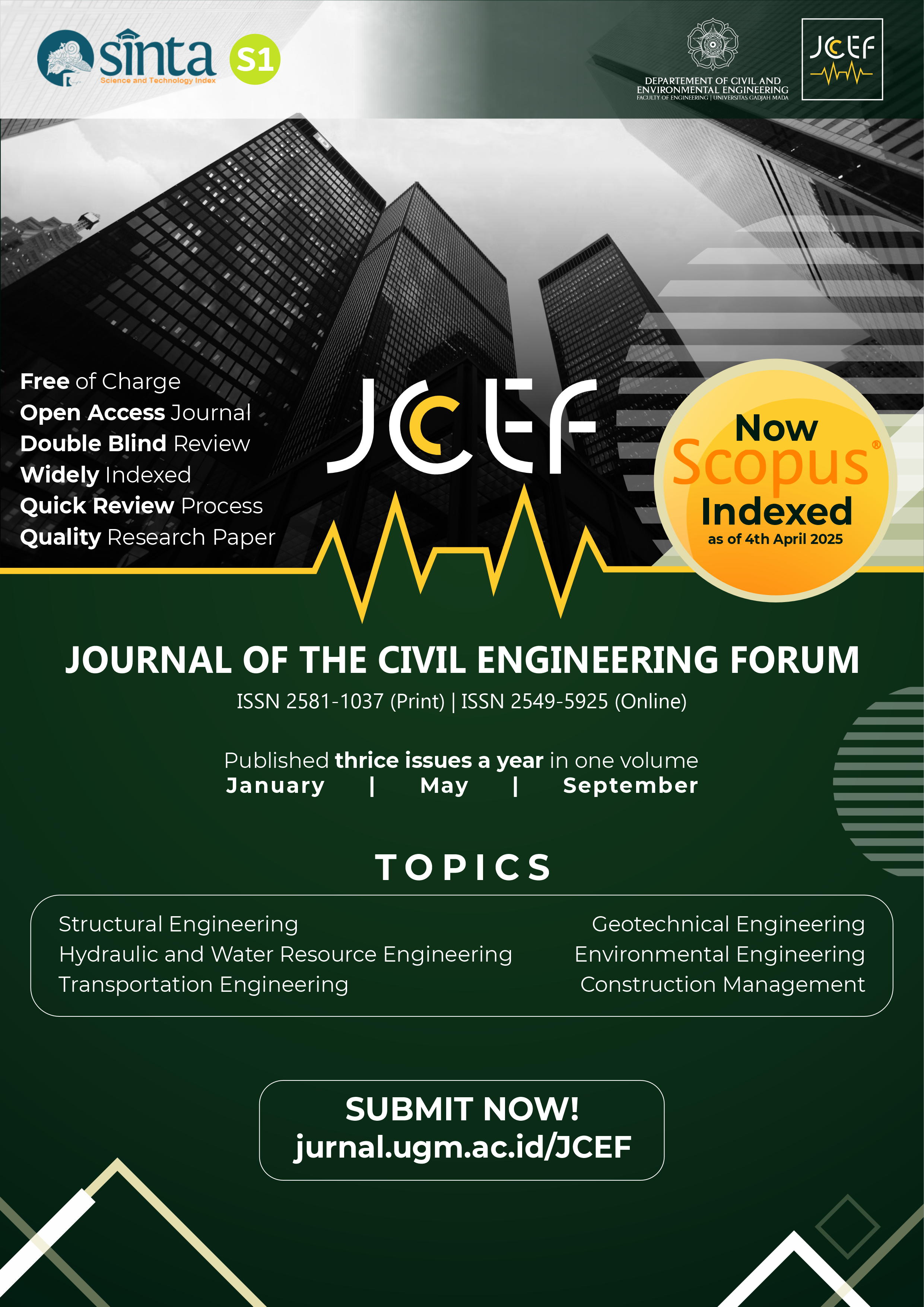The Performance of Ca(OH)2 to Reduce the Plasticity Index and Increase the Shear Strength Parameter for Expansive Soil
Abstract
The design on expansive soils can easily change in volume due to the influence of water content. This makes it necessary to consider soil improvement methods in the planning process to maintain the variation in the water content. One of these methods includes chemical stabilization, which is carried out by adding materials such as cement or lime. In expansive soils, stabilization efforts aim to reduce the plasticity index and increase the shear strength parameters. Therefore, this study focused on the addition of slaked lime (Ca(OH)2) to expansive soil in Lakarsantri, Surabaya. The stabilizing materials used contain calcium to form pozzolan in the clay and increase the bearing capacity parameter, which is variation in shear strength. The soil was taken at 2 points A and B with a different moisture content of 48.57% and 35.12%, as well as a high plasticity index value > 50% using a percentage (Ca(OH)2) of 6%-24% at a certain curing time. Based on the results, the plasticity index in the soil changed from very high to moderate with an optimum percentage value of 6% at 30 days of curing time. The optimum value of soil shear strength is (Ca(OH)2) 6% at 30 days of age in soil A, the cohesion value is 0.02 kg/cm2, and an internal shear angle of 36°. In soil B, the optimum shear strength obtained (Ca(OH)2) was 6% at the age of 10 days with a cohesion value of 0.14 kg/cm2 and an internal shear angle of 23.80°. Therefore, the results of this study show that the parameter of shear strength of the soil from the cohesion value showed that the cohesion value decreased with the addition of Ca(OH)2, while the internal shear angle increased.
References
Mishra, A. K., Dhawan, S., & Rao, S. M. (2007). ‘Analysis of swelling and shrinkage behavior of compacted clays’. Geotechnical and Geolog-ical Engineering, 26(3), 289–298.
Abdulaziz E.. et al, 2013. ‘Treatment of expan-sive soil with chemical addi-tive’. J. Eng. Sci, 41(5), pp.1765–1777.
Al-mukhtar, M., Khattab, S., and Alcover, J., 2012. ‘Microstructure and geotechnical prop-erties of lime-treated expansive clayey soil’. Engineering Geology. Elsevier B.V, pp.17–27. https://doi.org/10.1016/j.enggeo.2012.04.004.
Arora, K, 1998. Soil Mechanics and Foundation Engineering. I. Nai Sarak, Delhi. Delhi, India.
Arumairaj and Sivajothi, A, 2012. ‘Effect of sea water on expansive soils’. J. Geotech. Eng. (EJGE).
Basma, A. . and Al-Sharif, M., 1994. Treatment of expansive soils to control swelling. J.Geotech. Eng, 25(1), pp.3–19.
Elena, A. et al, 2020. ‘Penyebaran Karakteris-tik Tanah Ekspansif di Su-rabaya Berdasarkan Tingkat Kembang Susutnya’. Dimensi Pratama Teknik Sipil, 9(2), pp.7–14.
Fahoum, K., Aggour, M. S, and Amini., F, 1996. ‘Dynamics properties of cohesive soils treated with lime’. J. Geotech. Eng., 122(5), pp.382–389.
Fattah, M. Y., Salman, F. A, and Nareeman., B. J., 2010. ‘A treatment of expansive soil using different additives’. Acta Montanistica Slova-ca, 15(4), pp.290–297.
Horpibulsuk, S. et al, 2010. ‘Analysis of strength development in cement-stabilized silty clay from microstructural consid-erations’. Construction and Building Materi-als. Elsevier Ltd, 24(10), pp.2011–2021. https://doi.org/10.1016/j.conbuildmat.2010.03.011.
Jalal, F. E. et al., 2020. ‘On the Recent Trends in Expansive Soil Stabili-zation Using Calci-um-Based Stabilizer Materials ( CSMs ): A Comprehensive Review’. Hindawi Advances in Materials Science and Engineering. https://doi.org/10.1155/2020/1510969.
Liu, Y. et al., 2018. ‘Research on pavement performance of mixed filler with alkaline resi-due-expansive soil’. IOP Conf. Ser. Earth Envi-ron. Sci., 170. https://doi.org/doi: https://doi.org/10.1088/1755-1315/170/2/022148.
Mishra, Dhawan, and Rao, 2008. Analysis of swelling and shrinkage behavior of compacted clays. Geotechn. Geol. Eng, 26(3), pp.289–298.
Munirwan, R. P., 2017. ‘Stabilization On Ex-pansive Soil For Road-Subgrade For Geotech-nic Disaster Approach’. International Journal of Disaster Management, 1(January), pp.8–19.
Pan, Y, Li, M, and Dai, R., 2020. ‘Review on the progress of expansive soil im-provement in ten years’. IOP Conf. Ser. Earth Environ. Sci., 455. https://doi.org/ 10.1088/1755-1315/455/1/012112.
Patel, A., 2019. ‘Soil stabilization 3.1’. Ge-otechnical Investigations and Improvement of Ground Conditions, pp.19–27. https://doi.org/10.1016/B978-0-12-817048-9.00003-2.
Peck, R., Hanson, W, and Thornburn, 1980. Foundation Engineering.
Radhakrishnan, M., Kumar, A., and Raju, G. V. R. P., 2014. ‘Swelling properties of expansive soils treated with chemicals and fly ash’. Am. J. Eng. Res., 3(4), pp.245–250.
Sharma, A. K. and Sivapullaiah, P. V., 2016. ‘Ground Granulated Blast Furnace Slag Amended Ash As An Expansive Soil Stabilizer’. Soils Foundations, 56(2), pp.205–212.
Tang, C. et al., 2008. ‘Influencing factors of geometrical structure of surface shrinkage cracks in clayey soils’. Eng. Geol., 101(3–4), pp.204–217.
Jullis, T. et al. (2018) ‘Pengaruh Kapur Sebagai Stabilizing Agent Terhadap Indeks Plastisitas dan Kuat Geser Lempung Ekspansif Meunasah Rayeuk’, Rekayasa Sipil dan Perencanaan, 1(4), pp. 99–107.
Viswanadham, B. V. S., Phanikumar, B. R. and Mukherjee, R. V. (2009) ‘Swelling behaviour of a geofiber-reinforced expansive soil’, Geotext. Geomembr, 27(1), pp. 204–217.
Yilmaz, I. and Civelekoglu, B. (2009) ‘Gypsum: an additive for stabilization of swelling clay soils’, Appl. Clay Sci., 44(1–2), pp. 166–172.
Copyright (c) 2022 The Author(s)

This work is licensed under a Creative Commons Attribution-ShareAlike 4.0 International License.
Copyright is granted to authors for the purpose of providing protection for articles written to describe experiments and their results. JCEF will protect and defend the work and reputation of the author and are also willing to address any allegations of violation, plagiarism, fraud, etc. against articles written and published by JCEF. JCEF is published under the terms of the Creative Commons Attribution-ShareAlike 4.0 International License (CC BY-SA 4.0). The author holds the copyright and assigns the journal rights to the first publication (online and print) of the work simultaneously.






